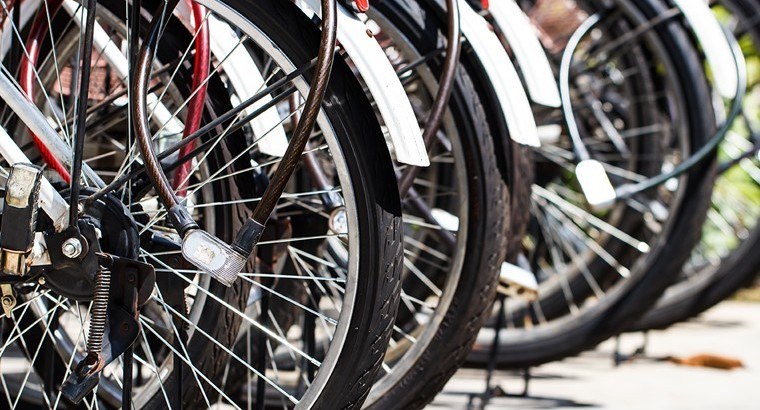
Bicycles can be some of the easiest vehicles for thieves and vandals to target. If your bike falls prey to a thief despite your best efforts, take a few simple steps to make it harder to steal and easier to recover.
Pick your pitch
The simplest solution to bike security is to keep your bike in sight or behind a locked door. That way a bike lock is optional. At home, the bike lives in your house on a wall-mounted rack or a telescopic bike stand that fits between floor and ceiling. At work, your employer provides a lockable bike store. If your partner, landlord or employer isn’t keen on you wheeling your bike over the threshold, a compact folding bike is a solution.
Home security
Since most bikes are stolen from the owner’s property but not from the home itself, any bike that doesn’t live under your roof must be secure. A padlock on a wooden shed or a lockable up-and-over garage door isn’t enough. Buy the best ground anchor you can afford (Abus, Squire and Pragmasis all do good ones) and fix it into a concrete floor or, if that’s not feasible, a brick wall. Attach your bike to this through the frame with a thick, hardened-steel chain. You won’t carry this chain on the bike, so weight doesn’t matter.
Work security
You should store your bike indoors whenever possible. At work, ask your employer whether the company can provide a locked garage where employees can store their bikes. If you are storing in your bike in an area where anyone else has access, you must lock your bike through the frame to an immovable object using a Sold Secure approved lock of a rating that corresponds with the insured value of your bike. The maximum amount of time that may elapse after you have left your bike unattended is 12 hours.
Lock it right
D-shaped shackle locks can be the most secure but an armoured cable lock may give better flexibility – if you need to lock it onto a lamppost for example. Also, think about the weight of your lock – you need to make sure you or your bike can carry it comfortably! Visit www.whycycle.co.uk/safety-locks.htm to get some ideas on locks, or take your bike into your local bicycle shop and get their expert advice. You can also get locks for wheels, usually in the form of a long cable that threads through the spokes and attaches to your main lock. If you don’t have one of these the best idea might be to take your wheels with you when you park up. Some wheels are highly prized even without the rest of the bike! The same applies to seats and lights – if in doubt, take them with you.
Location, location, location
Lock your bike in highly visible place rather than down an alley and ensure it is locked to something solid and secure so thieves can’t lift your bike up and over a pole or post. ID your bike by getting it postcoded by the police. Or you can register it with Immobilise at www.immobilise.com. This is a free register of possession that links up with the Police National Stolen Equipment Database. It’s also wise to take a photo of your bike in case you need proof of its identity for police. For more top tips on bike security visit Bike Register.
Protecting bits and pieces
Any component with a quick release lever can be removed in seconds; at the least, use Allen bolts instead. The next step is to use security skewers, which require a special key.These are available for wheels, seat collar, stem top cap (to prevent fork theft), and more from Pitlock and Pinhead. Accessories that clip off your bike, such as battery lights, pump, and computer must go with you when your park your bike in public.
Smart Water your bike
Smart Water is invisible to the naked eye and can only be seen under ultra-violet light. Each application has a unique code, which is linked to a person or address giving it the nickname of ‘liquid DNA’. Your local police force may be able to help you Smart Water the frame of your bike.
When the worst happens
Getting your bike stolen is never a nice experience. However, the next steps you take will greatly improve your chances of recovering your bike. Ideally, take these steps as soon as possible.
The first step is to report your bike stolen to the police. You can find your local station by visiting http://www.police.uk/. Ideally, you will need a frame number and a tag. If you’ve got bike insurance, then you’ll need to report the theft within 24 hours of discovery. The crime reference number the police will give you, combined with a receipt for your bike will help you make a claim. Whilst only 4% of bikes are recovered, it’s important that the police have accurate figures so they can allocate resources to fight bike crime.
Cycle insurance is essential. Check household policies with care: bikes may be covered only up to a certain value or in certain locations. A dedicated cycle policy may be a better bet. Get quotes from Cycleguard or from a selection of cycling organisations such as British Cycling, CTC, LCC and Chain Reaction Cycles.
Bike theft can be frustrating, but with a little effort, you can reduce your risk and increase your chances of recovering your ride. And, though it can be a hassle if it happens to you, try to keep it in perspective. Biking is still an excellent deal!
